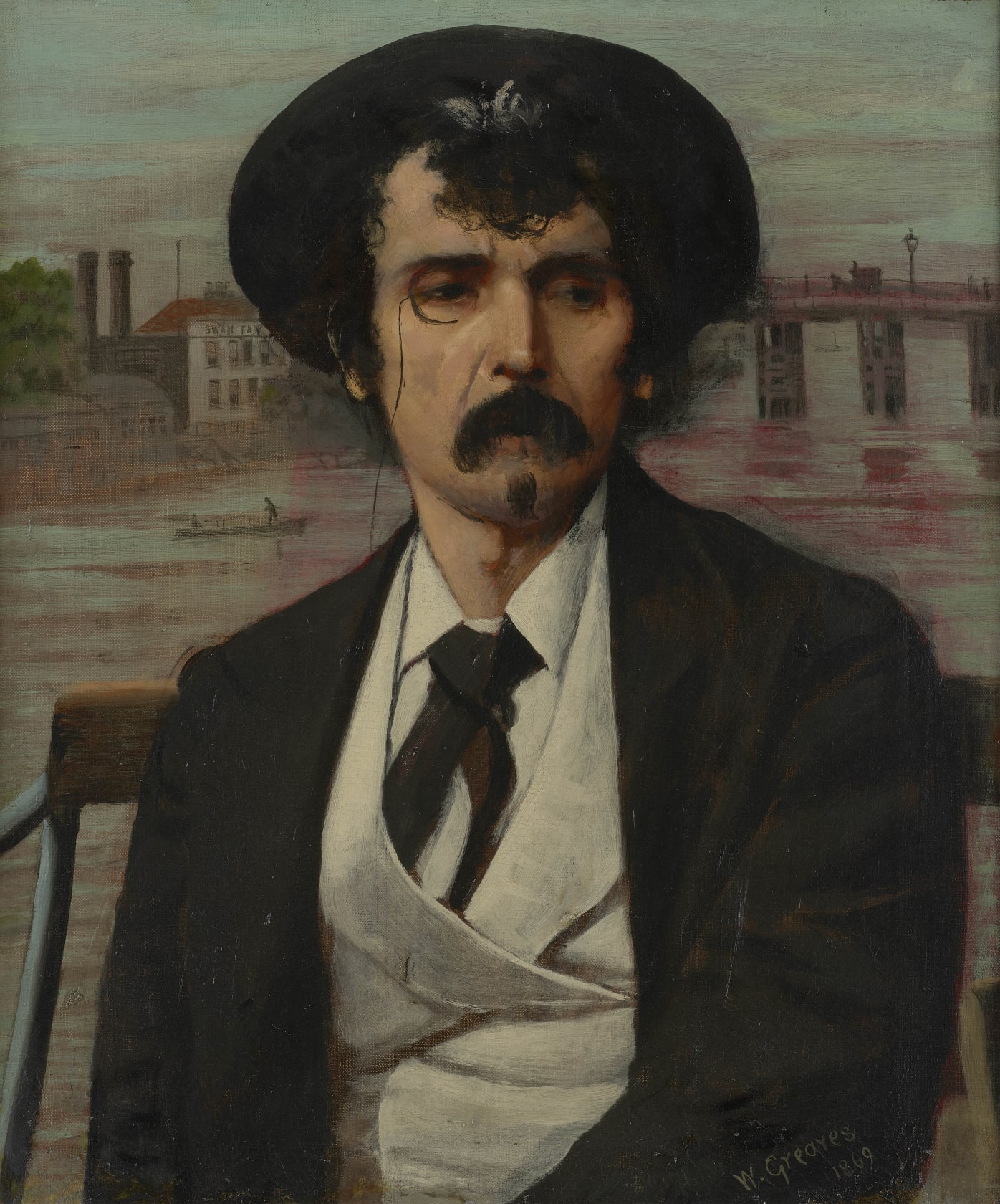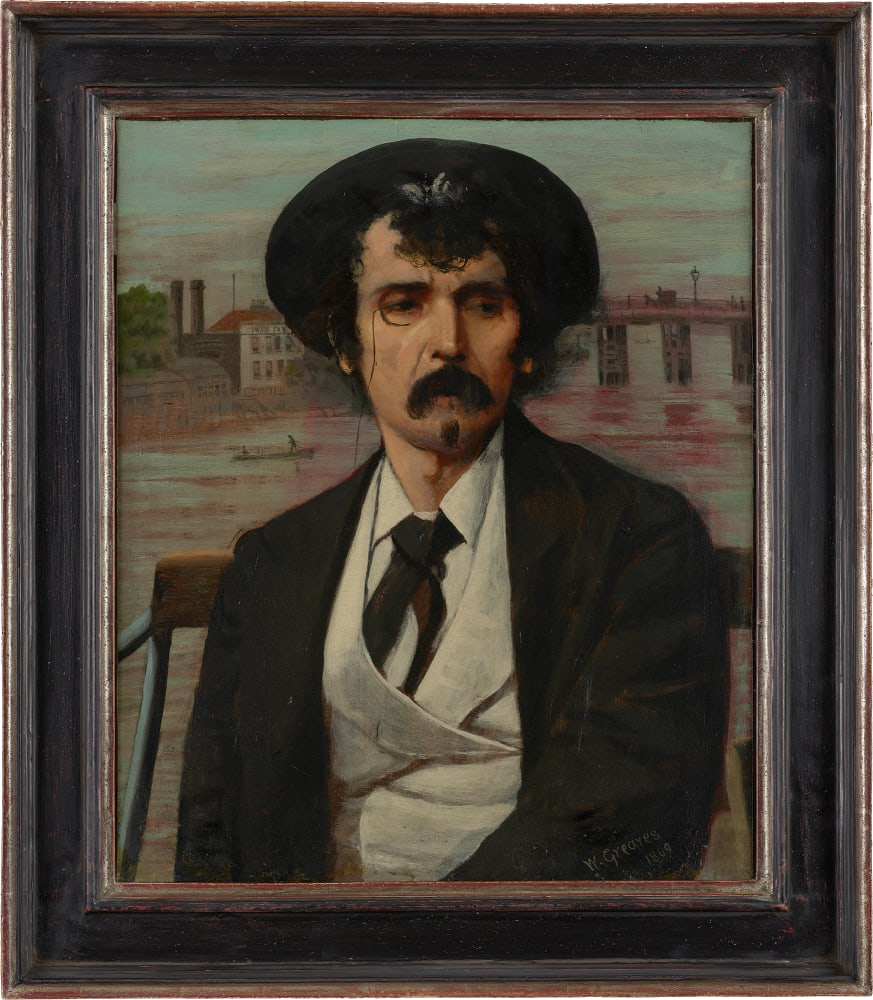


Walter Greaves
(1846-1930) Portrait of James Abbott McNeill Whistler (1834-1903), with the old Battersea Bridge and the Swan Tavern beyondProvenance
The artist, by whom sold; Anderson Galleries, New York, 5 March, 1912, lot 28;
Bought from above by E.D. Brooks;
Thence by descent, until 2017;
Weschler's, Maryland, 3 February 2018, lot 189;
Philip Mould & Company, acquired from the above.
Literature
Anon. (1912) ‘Whistler Drawings Sold’, New York Times, 6 March, p. 20;
Gallatin, A. E. (1918) Portraits of Whistler: A Critical Study and An Iconography, New York: John Lane Company. No. 36, p. 35.
We are grateful to Jacqui Ansell, Senior Lecturer Christie’s Education, for her commentary on men’s fashion which has been incorporated into this catalogue note.
Great colourists know how to create colour with a black coat, a white cravat, and a grey background.-
Charles Baudelaire, 1846.[1]
Walter Greaves’s portraits are amongst the most iconic within Whistler’s iconography and the present work, painted in 1869, is one of the earliest recorded examples by Greaves. It was clearly of great sentimental value to the artist and it remained in his possession until 1912 when it was sold in New York as part of his collection of Whistler memorabilia.
This strikingly modern portrait reflects the dramatic modernisation of men’s fashion during the nineteenth century. Whistler is shown seated, possibly in a boat, and maintains an image of a flaneur, a term was coined by his friend Charles Baudelaire, who urged artists to celebrate ‘the Heroism of Modern Life’. Baudelaire issued a...
We are grateful to Jacqui Ansell, Senior Lecturer Christie’s Education, for her commentary on men’s fashion which has been incorporated into this catalogue note.
Great colourists know how to create colour with a black coat, a white cravat, and a grey background.-
Charles Baudelaire, 1846.[1]
Walter Greaves’s portraits are amongst the most iconic within Whistler’s iconography and the present work, painted in 1869, is one of the earliest recorded examples by Greaves. It was clearly of great sentimental value to the artist and it remained in his possession until 1912 when it was sold in New York as part of his collection of Whistler memorabilia.
This strikingly modern portrait reflects the dramatic modernisation of men’s fashion during the nineteenth century. Whistler is shown seated, possibly in a boat, and maintains an image of a flaneur, a term was coined by his friend Charles Baudelaire, who urged artists to celebrate ‘the Heroism of Modern Life’. Baudelaire issued a rallying call to artists to reflect modern, rather than traditional fashion trends. Greaves and Whistler heed this through Whistler’s double-breasted white waistcoat and cloth jacket, which is far less structured than previous traditional styles and lacks the padding and restrictive tailoring of Georgian equivalents. The collar of the shirt is relatively soft, and the tie is loose, in contrast to the stiff collar and cravats worn in the era of George IV. Tight-fitting, ankle-length trousers were introduced by dandy, Beau Brummell, in the early nineteenth century. They were to be worn with either matching or contrasting jacket which formed a well-tailored suit. By the 1820s men’s trousers had replaced knee breeches for everyday wear.
The term flaneur was synonymous with scrutinising and observing and this sense of observation is implicit in the stylish monocle which Whistler wears, and the gaze with which he surveys the scene. Whistler glances away in a haughty manner, his hat tilted back to show his famous ‘white lock’. It is evident from this and many other portraits of Whistler that he evidently cared about his appearance, and here he has cultivated a look of leisured ease. Old Battersea Bridge (built in 1771) is shown in the background and on the left can be seen the Swan Tavern. This area of the Thames was frequently painted by Greaves and Whistler, both of whom lived nearby – the latter lived at 2 Lindsey Row (now 96 Cheyne Walk), a few metres from where Whistler is shown here.
After becoming neighbours in 1863, a friendship developed between Whistler and Greaves. Walter and his brother Henry were boatmen and found employment rowing Whistler up and down the Thames whilst he made studies of London, just as their father had previously done for J.M.W. Turner. Graves would later reminisce “He taught us to paint, and we taught him the waterman’s jerk”.
Greaves was already an accomplished artist, although his style was somewhat literal and based on close observation. Whistler, however, was developing a style which was looser and more confident which made a great impression on Greaves who soon fell under Whistler’s influence. It was said that Greaves would even dress like Whistler and wear gloves and a hat complemented by a Whistler-style moustache. Greaves received some tuition from Whistler and in 1876 he was invited to assist him with an important commission to decorate the dining room of a Kensington townhouse owned by shipping magnate Frederick Leyland (1831-1892). Known as The Peacock Room, it is regarded as one of Whistler’s greatest artistic achievements and is now on display at the Freer Gallery of Art in Washington, DC.
As Whistler’s reputation grew he began to attract a more illustrious clientele, and after moving to a more affluent area of London he began to distance himself from Greaves. Following Whistler’s marriage 10 years later communication ceased entirely and in 1903 Whistler died.
After struggling for many years to sell his work, Greaves experienced a resurgence of interest in 1911 following an exhibition of his work at the Goupil Galleries in London. Although the exhibition was a great success, it was forced to close early after two of Whistler’s friends claimed some of Greaves’s paintings were actually unfinished works by Whistler which Greaves stole from his studio and reworked. The scandal destroyed Greaves’s reputation and ruined him financially, which may explain his decision to sell his cherished collection of Whistler memorabilia the following year at auction – our portrait was lot 28.
For another decade Greaves lived as a recluse but then in 1921 a group of painters including William Rothenstein (1872-1945) and Augustus John (1878-1961) staged a successful exhibition of his work which led to his election as an honorary member of the Chelsea Arts Club. In 1930, after finally receiving some recognition as a painter, Greaves died of pneumonia and was buried in the Charterhouse graveyard at Little Hallingbury in Essex.
[1] Baudelaire, C. (1846) On the Heroism of Modern Life.





